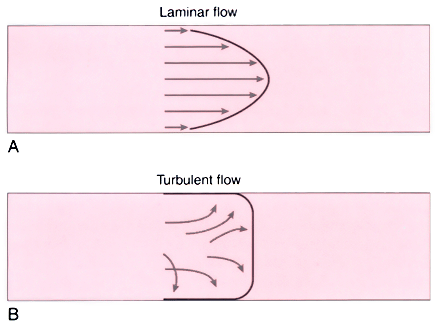Figure 30-16
Laminar and turbulent flow. In a smooth-walled tube
at low flow rates (i.e., small pressure gradients), the flow rate is laminar; that
is, flow moves smoothly in concentric circles, with the centermost area having the
greatest flow velocity and the area nearest the wall of the tube being virtually
stationary. As the flow rate (and pressure gradient) increases, the flow transitions
from laminar to turbulent. Instead of a neatly ordered flow, the velocities are
more randomly distributed, energy is dissipated as heat, and the energy needed for
a given flow rate increases. Many factors govern this transition, including size
of the tube, viscosity of the fluid, flow rate, and pressure gradient. These factors
are combined in determination of the Reynolds number (see Appendix
5
).

